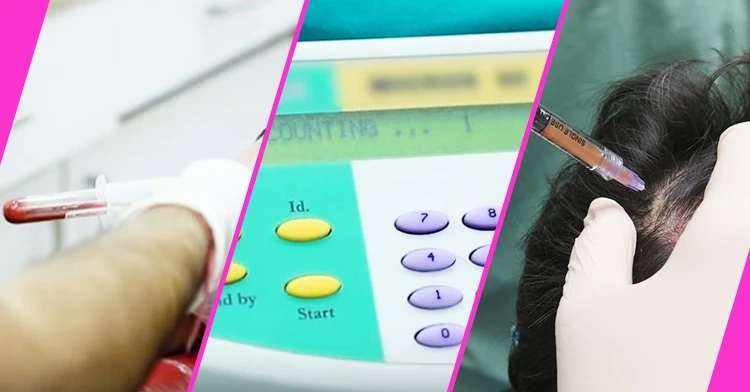A minimally invasive surgical procedure called a hair transplant is designed to produce long-lasting, realistic results. Although there are many alternatives to hair transplants currently in use, none of these treatment options can produce lasting results. Despite the fact that there are numerous adjunct treatment options, they could improve the results of a hair transplant.
What is platelet-rich plasma, or PRP?
One of the blood cells, platelets play a crucial role in blood clotting and are an essential part of the body's natural healing process.
Platelet rich plasma (PRP) is a first-generation platelet concentrate made from your own blood and is intended to speed up the body's own healing and growth processes. Wherever it is injected, its abundance in growth factors creates a favorable environment that promotes cellular growth and development. It was created in the 1980s and has been used ever since to quicken the healing of injured tendons, ligaments, muscles, and joints.
Function of the PRP restoration technique:
The growth factors in PRP act as messengers, signalling to cells to function and undergo facilitated growth. They are currently used for a variety of medical conditions, including gum surgery, arthritic symptoms, and aging. PRP therapy also plays a role in patients with "thinning hairs" in addition to these indications. The growth factor aids in boosting hair follicular activity and encourages the growth of new hair.
What happens during PRP therapy?
PRP therapy has been successfully used to treat a variety of medical conditions, including arthritis, aging symptoms, and gum surgery. The growth factors that the platelets release serve as messengers, informing the cells to improve their development and function.
PRP therapy is used to stimulate hair growth by increasing hair follicular activity in the early stages of the hair thinning process. PRP is injected wherever it is desired. In addition, PRP therapy is combined with hair transplantation and is started after the hair transplantation session.
Hair loss treated with PRP?
PRP therapy is a cutting-edge method added as a hair loss treatment that aims to improve hair growth by improving the blood supply to the targeted areas of the scalp. According to reports, PRP treatment has slowed down hair miniaturization and thinning while also reducing the rate of hair loss. Early hair loss is known to be successfully treated in order to stop further baldness. However, the only option for having permanent hair growth in cases of obvious baldness is a hair transplant.
PRP therapy following a hair transplant procedure?
In order to improve the healing process after surgery and to promote quicker hair growth after the procedure, PRP therapy has been added to hair transplant procedures. The newly implanted hair grafts are given a very hospitable environment, which promotes hair growth as cellular activity increases. As a simple and non-invasive option, PRP hair restoration is quickly gaining popularity among those who suffer from hair loss.
PRP hair restoration is typically tried in the early stages of baldness before considering hair transplant procedures.
PRP therapy procedure:
Your own blood is drawn and processed to create the PRP. The following is an explanation of the PRP preparation steps:
First, blood is drawn from the patient's arm and centrifuged for 10 minutes before being returned to the patient. Platelets are collected as a separate layer at a speed of 3000 rpm because the centrifugation process separates molecules with different densities.
Step 2: Following thorough centrifugation, we obtain three layers, each of which is made up of the following individual components:
Top most layer: platelet poor plasmaMiddle layer: platelet rich plasmaLast layer: red blood cellsStep 3: The prepared PRP is gathered in a syringe and injected wherever needed around the implanted hair follicles. The injection is given every half-inch, either around thinning hair follicles or newly transplanted hair follicles after a hair transplant, making this procedure time-consuming.
Three injections of PRP injection therapy are scheduled for appointments every four to six weeks. The maintenance phase is planned to come after them once every four to six months.
Is PRP therapy helpful for getting the best results from hair transplants?
Nowadays, PRP therapy is a common technique used at hair transplant clinics to speed up the presentation of results and encourage hair growth after the procedure. If you were to ask me if this procedure yields the best results, I would undoubtedly respond in the affirmative—but only if it is executed flawlessly.
To get the best results, you need to inject the right number of platelets into the target area. In order to assure to the best outcomes, we at the Medispa hair transplant clinic use an analyzer to recheck the concentration of the platelets after the preparation. PRP therapy is therefore widely accessible, but to receive the most effective PRP therapy and get the best results, go to a Medispa hair transplant clinic in Delhi or Jaipur.


